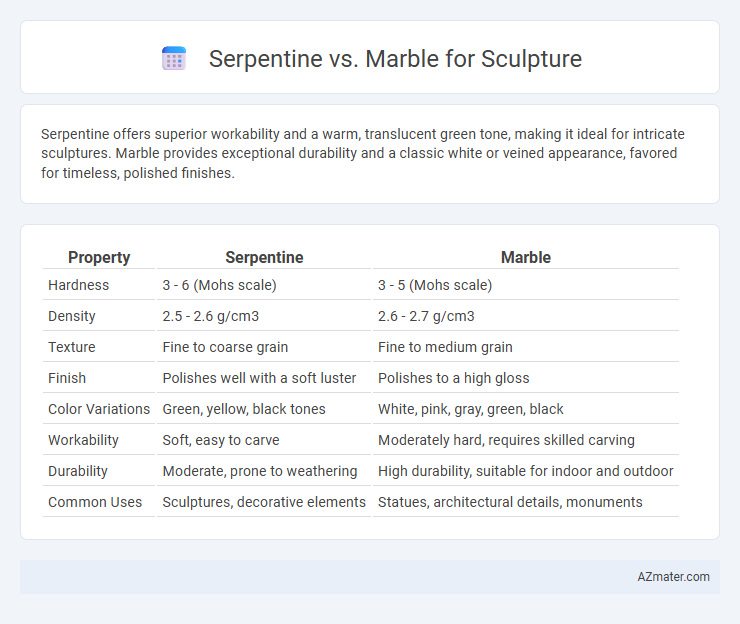Serpentine offers superior workability and a warm, translucent green tone, making it ideal for intricate sculptures. Marble provides exceptional durability and a classic white or veined appearance, favored for timeless, polished finishes.
Table of Comparison
| Property | Serpentine | Marble |
|---|---|---|
| Hardness | 3 - 6 (Mohs scale) | 3 - 5 (Mohs scale) |
| Density | 2.5 - 2.6 g/cm3 | 2.6 - 2.7 g/cm3 |
| Texture | Fine to coarse grain | Fine to medium grain |
| Finish | Polishes well with a soft luster | Polishes to a high gloss |
| Color Variations | Green, yellow, black tones | White, pink, gray, green, black |
| Workability | Soft, easy to carve | Moderately hard, requires skilled carving |
| Durability | Moderate, prone to weathering | High durability, suitable for indoor and outdoor |
| Common Uses | Sculptures, decorative elements | Statues, architectural details, monuments |
Introduction to Serpentine and Marble for Sculpture
Serpentine and marble are prized stones in sculpture, each offering unique aesthetic and physical properties. Serpentine exhibits a rich green hue with a smooth texture that is relatively soft and easy to carve, making it popular for intricate, detailed work. Marble, renowned for its classic white or veined appearance, offers exceptional durability and a fine grain that allows for polished, refined sculptures with lasting elegance.
Geological Origins: Serpentine vs Marble
Serpentine originates from the alteration of ultramafic rocks, characterized by its rich magnesium and iron content, forming through metamorphic processes in subduction zones. Marble is a metamorphic rock derived from the recrystallization of limestone or dolomite, predominantly composed of calcite or dolomite minerals. The geological origins significantly influence their texture and workability, with serpentine offering varied colorations due to mineral inclusions, while marble presents a more uniform and crystalline structure ideal for fine sculptural details.
Physical Properties: Hardness, Texture, and Color
Serpentine offers a hardness of 3 to 5 on the Mohs scale, making it softer and easier to carve compared to marble, which rates around 3 to 4 but with a denser, more crystalline structure. Serpentine features a smooth, waxy texture with a range of green, yellow, and brown hues, while marble is renowned for its fine-grained texture and classic white to gray coloration with veining. The softer nature of serpentine allows for intricate detailing, whereas marble's durability and polished finish provide a timeless, elegant appearance in sculpture.
Workability: Ease of Carving and Finishing
Serpentine offers superior workability due to its softer texture, making it easier to carve intricate details and smooth finishes compared to marble. Marble, though harder and denser, provides durability and a polished surface that enhances fine sculptural lines but requires more effort and specialized tools to shape. Sculptors often choose serpentine for detailed, delicate work, while marble is preferred for monumental pieces demanding lasting strength and classic aesthetics.
Durability and Weather Resistance
Serpentine, known for its moderate durability and relatively good resistance to weather, is often chosen for outdoor sculptures where weathering is a concern. Marble, while prized for its classic beauty and fine grain, is softer and more porous, making it more susceptible to erosion and damage from acid rain and freeze-thaw cycles. Sculptors seeking longevity in harsh environments typically prefer serpentine due to its superior toughness and resistance to environmental elements compared to marble.
Aesthetic Differences: Visual Appeal in Sculptures
Serpentine exhibits a rich, deep green coloration with veins and mottled patterns that create a dynamic, organic visual texture, enhancing sculptures with a naturalistic and earthy appeal. Marble offers a pristine, smooth surface with translucent qualities and subtle veining that convey elegance and timelessness, perfect for finely detailed and classical sculptures. The choice between serpentine and marble significantly affects the final aesthetic, with serpentine providing a bold, textured look while marble delivers a refined, luminous finish.
Cost and Availability of Materials
Serpentine is generally more affordable and widely available compared to marble, making it a popular choice for sculptors seeking cost-effective materials. Marble, especially high-quality varieties like Carrara or Calacatta, tends to be more expensive due to limited quarries and higher demand in fine art. The availability of serpentine varies globally but is often easier to source domestically, while marble extraction is concentrated in specific regions such as Italy and Greece, impacting both price and accessibility.
Historical and Cultural Significance
Serpentine and marble have both held prominent roles in sculpture throughout history, with marble famously used in Classical Greek and Roman art to symbolize purity and divine beauty. Serpentine, rich in green tones and often found in ancient Asian and Indigenous carvings, carries cultural significance linked to spirituality and natural elements. The choice between serpentine and marble not only reflects the sculptor's artistic intent but also the cultural narratives embedded in these materials.
Suitability for Indoor vs Outdoor Sculptures
Serpentine offers superior weather resistance and durability, making it well-suited for outdoor sculptures exposed to varying climates and moisture. Marble, prized for its fine grain and smooth finish, excels in indoor environments where temperature and humidity are controlled, preserving detailed carving and preventing erosion. While serpentine's toughness withstands outdoor elements, marble's aesthetic appeal and softness favor intricate indoor artistic expressions.
Choosing the Right Stone: Factors to Consider
Serpentine offers a softer texture and rich green hues, making it ideal for detailed, intricate sculptures and indoor pieces due to its relative softness and susceptibility to weathering. Marble provides exceptional durability and a classic, smooth finish with a wide range of colors, favored for large-scale, outdoor sculptures that require longevity and resistance to elements. When choosing between serpentine and marble, consider factors like the sculpture's intended location, desired detail level, weather exposure, and the artist's preferred carving technique to ensure material compatibility with the project's goals.

Infographic: Serpentine vs Marble for Sculpture
 azmater.com
azmater.com